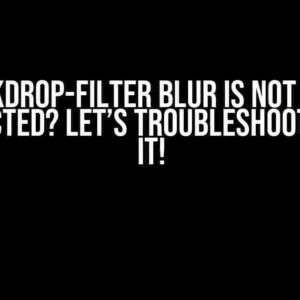Are you tired of wrestling with NextJS 14’s Next Image component and Tailwind CSS? Do you find yourself scratching your head, wondering why the `fill` property refuses to play nice with your beautifully crafted CSS classes? Fear not, dear developer, for we’re about to embark on a thrilling adventure to conquer this perplexing issue!
What’s the Problem, Anyway?
When using NextJS 14’s built-in `next/image` component with Tailwind CSS, you might have encountered an infuriating issue where the `fill` property simply doesn’t work as expected. You’ve tried applying the `object-cover` or `object-contain` classes, but your images stubbornly refuse to scale or fit the container as desired. It’s as if the `fill` property has vanished into thin air!
The Culprits: NextJS 14’s New Image Component and Tailwind CSS’s Utility-First Approach
NextJS 14 introduced a revamped `next/image` component, which, although powerful, has some unexpected behavior when paired with Tailwind CSS. The `fill` property, a crucial aspect of responsive image rendering, becomes finicky due to the way Tailwind CSS handles utility classes.
Tailwind CSS’s utility-first approach, while fantastic for rapid development, can sometimes lead to conflicts with other libraries or components. In this case, the `object-*` classes, which should work harmoniously with the `fill` property, lose their magic when used alongside NextJS 14’s `next/image` component.
The Solution: Understanding and Tweaking Next Image and Tailwind CSS
Don’t worry; we’re not going to leave you hanging! With a solid understanding of NextJS 14’s `next/image` component and Tailwind CSS’s inner workings, we can tame this beast and get the `fill` property working as intended.
Step 1: Understanding the `next/image` Component
The `next/image` component is a powerful tool for optimizing and rendering images in NextJS 14. It provides several props to customize the image rendering, including the `fill` property. However, it’s essential to grasp how the `fill` property works in conjunction with the `object-*` classes.
<Image src="/image.jpg" alt="My Image" fill={true} className="object-cover"/>
In the example above, we’re using the `fill` property to instruct the image to fill its container, while applying the `object-cover` class to scale the image accordingly. Sounds straightforward, right?
Step 2: Dissecting Tailwind CSS’s Utility Classes
Tailwind CSS provides a range of utility classes to quickly style your components. The `object-*` classes, specifically, are designed for responsive image rendering. However, these classes rely on the `display` property being set to `block` or `inline-block` to function correctly.
.object-cover {
object-fit: cover;
width: 100%;
height: 100%;
font-size: 0; /* Remove font size to ensure correct scaling */
}
Notice how the `object-cover` class sets `object-fit` to `cover`, which is essential for the image to scale correctly. However, the `display` property is not explicitly set, which can lead to conflicts with the `next/image` component.
Step 3: Tweaking the `next/image` Component and Tailwind CSS
To get the `fill` property working with Tailwind CSS, we need to make a few adjustments:
-
Wrap the `next/image` component with a container element (e.g., `div`) and apply the desired `object-*` class to it:
<div className="object-cover"><Image src="/image.jpg" alt="My Image" fill={true} /></div> -
Use the `display` property to set the container element to `inline-block` or `block`, ensuring the `object-*` classes work as intended:
<div className="object-cover inline-block"><Image src="/image.jpg" alt="My Image" fill={true} /></div> -
Alternatively, use the `w-full` and `h-full` classes to set the container element’s width and height to 100%, allowing the `fill` property to work correctly:
<div className="w-full h-full object-cover"><Image src="/image.jpg" alt="My Image" fill={true} /></div>
example Use Cases and Troubleshooting
Now that we’ve conquered the `fill` property issue, let’s explore some example use cases and troubleshooting tips:
Example 1: Responsive Image Gallery
| Image | Code |
|---|---|
 |
<div className="w-full h-full object-cover"><Image src="/image1.jpg" alt="Image 1" fill={true} /></div> |
 |
<div className="w-full h-full object-contain"><Image src="/image2.jpg" alt="Image 2" fill={true} /></div> |
Troubleshooting Tips
If you’re still experiencing issues with the `fill` property, try these troubleshooting tips:
-
Verify that you’ve wrapped the `next/image` component with a container element and applied the desired `object-*` class.
-
Check that the `display` property is set to `inline-block` or `block` on the container element.
-
Ensure that the container element has a defined width and height, or use the `w-full` and `h-full` classes to set them to 100%.
-
If using a CSS framework or custom styles, inspect the `object-*` classes to ensure they’re not being overridden.
Conclusion
Voilà! With these simple adjustments and a solid understanding of NextJS 14’s `next/image` component and Tailwind CSS’s utility classes, you should now be able to get the `fill` property working as intended. Remember to wrap the `next/image` component with a container element, apply the desired `object-*` class, and set the `display` property to `inline-block` or `block`. Happy coding!
Here are 5 FAQs about “NextJS 14 Next Image fill property not working with tailwind CSS”:
Frequently Asked Question
Are you having trouble getting the `fill` property to work with `next/image` in NextJS 14 and Tailwind CSS? Don’t worry, we’ve got you covered! Check out these frequently asked questions to troubleshoot the issue.
Why is the `fill` property not working with `next/image` in NextJS 14 and Tailwind CSS?
The `fill` property is a new addition to `next/image` in NextJS 14, and it requires a specific configuration to work with Tailwind CSS. Make sure you have the `experimental` flag enabled in your `next.config.js` file and that you’re using the `tailwindcss` plugin correctly.
Do I need to install any additional packages to get the `fill` property working?
Yes, you need to install `@tailwindcss/aspect-ratio` to use the `fill` property with Tailwind CSS. This package provides the necessary utility classes for aspect ratios, which are required for the `fill` property to work.
How do I configure my `tailwind.config.js` file to work with the `fill` property?
You need to add the `aspectRatio` utility to your `tailwind.config.js` file and make sure it’s enabled. You can do this by adding the following code: `module.exports = { utilities: { aspectRatio: true } }`. This will enable the aspect ratio utility, which is required for the `fill` property to work.
What if I’m still having trouble getting the `fill` property to work with my custom image component?
Make sure your custom image component is using the `next/image` component correctly. Check that you’re importing the `Image` component from `next/image` and that you’re using the `fill` property correctly. Also, ensure that your custom component is not overriding the `fill` property with its own styles.
Can I use the `fill` property with other CSS frameworks besides Tailwind CSS?
Yes, you can use the `fill` property with other CSS frameworks besides Tailwind CSS. However, you may need to configure your CSS framework to work with the `fill` property correctly. Check the documentation of your CSS framework to see if it has built-in support for aspect ratios and the `fill` property.


